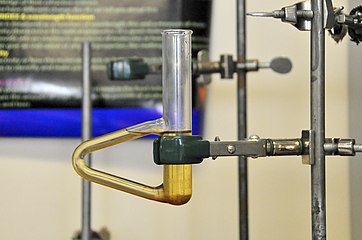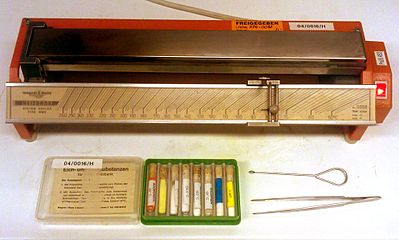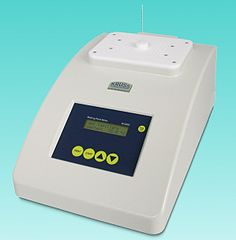Melting point
![]()
The title of this article is ambiguous. For an explanation of the term "melting temperature" in genetics, see deoxyribonucleic acid.
Melting point (Mp.) is the temperature at which a substance melts, i.e. changes from a solid to a liquid state. The melting temperature depends on the substance, but in contrast to the boiling temperature, it depends very little on the pressure (melting pressure). Melting temperature and pressure together are called melting point, which describes the state of a pure substance and is part of the melting curve in the phase diagram of the substance. Some substances cannot melt because they decompose chemically beforehand, and others can only sublime under normal conditions.
For pure chemical elements, the melting point is identical to the freezing point and remains constant throughout the melting process. The melting temperature is usually lowered by impurities or in the case of mixtures (melting point depression), and the temperature can also rise during the melting process, which means that we are dealing with a melting range. The lowering of the melting point (cryoscopy) by dissolved substances is one reason why ice can be melted by salt.
In contrast to chemical elements, deviations between melting point and freezing point can also occur with pure chemical compounds. If the freezing point temperature is below the melting point temperature, this is called thermal hysteresis. This is the case, for example, with pure water; without nucleation nuclei and under a pressure of 1 bar, water freezes at approx. -40 °C and melts at approx. 0 °C. In the case of amorphous materials such as glasses and some plastics, one speaks of the transition temperature. It is also possible to define a softening temperature.
The melting temperature, together with density, fracture toughness, strength, ductility and hardness, is one of the material properties of a material.
The element neptunium has the largest liquid range from 630 °C to 3900 °C, i.e. above 3270 °C. The smallest liquid range from -248.6 °C to -246.3 °C has the noble gas neon with 2.3 °C.
Pressure dependence
The melting point does depend on the pressure, but only slightly: to change the melting point by just 1 K, the pressure must be increased by about 100 bar on average. It follows that changes in atmospheric pressure - which can cause noticeable changes in the boiling point - have practically no effect on the melting point.
For melting, as for other phase transformations, the Clapeyron equation applies, which gives the following temperature change ΔT as a good approximation for melting at different pressures:
Here TM is the melting point, ΔV the volume change during melting, Δp the difference of the pressures considered, and HM the enthalpy of fusion. However, since the volume changes ΔV during melting are relatively small, the pressure dependence of the melting point is also relatively small. For example, increasing the pressure by 100 bar changes the melting point of ice by -0.76 K. Thus, ice melts more easily under pressure, while the melting point of carbon tetrachloride increases by +3.7 K. The fact that the melting point of ice or, for example, bismuth decreases with an increase in pressure follows from the fact that their volume is reduced during melting: Then in the above equation ΔV and ΔT is negative.
Analytics
The determination of the melting point of a substance is also of great importance in qualitative analysis, including identity testing, as many substances can be identified by their melting point. The purity of substances can also be measured qualitatively via the melting point. Impurities result in lower melting points. Liquid substances or those with a low melting point are converted into easily crystallizing derivatives for this purpose: Alcohols, for example, can be identified by measuring the melting points of their esters of 4-nitrobenzoic acid or 3,5-dinitrobenzoic acid. For this purpose, the substance to be analyzed is reacted in the presence of small amounts of sulfuric acid. The melting points of these derivatives are usually sharp.
|
|
|
| Detection of isopropanol as derivative of 4-nitrobenzoic acid: | Detection of isopropanol as derivative of 3,5-dinitrobenzoic acid: |
The derivatives of 3,5-dinitrobenzoic acid usually have higher melting points than those of 4-nitrobenzoic acid. They are then preferably chosen if the melting point with 4-nitrobenzoic acid is too low and an accurate determination is no longer possible.
Extensive tables with information on the melting points of organic compounds are available as important aids for analysts. Melting points of derivatives of individual substance classes are listed in the relevant textbooks on organic analysis.
Determination
An approximate measurement can be made with a thermometer by melting the sample and reading the melting temperature.
Different methods are available for the exact measurement of the melting point:
- Apparatus according to Thiele, in which the sample is melted in a stirred or convection-flowing oil bath.
- apparatus according to DAB, with standard ground joint 29/32, consisting of flask of approx. 100 ml and insert tube with vent hole
- Apparatus according to Dr. C. F. Linström (often incorrectly spelled Lindström), in which the sample is heated to the melting point in a copper block.
- Heating table apparatus according to Kofler (see also Kofler heating bench), Tottoli
- Differential Scanning Calorimetry (DSC)
- In the capillary method, the substance to be examined is placed in a glass capillary. This is inserted into a preheated heating block and the temperature is slowly increased. The melting temperature is the temperature at which the last solid particle melts.
· 
Melting point determination apparatus according to Thiele
· 
Kofler bench with samples for calibration
· 
Automatic melting point meter M5000
Most often, the measured values are marked with the fact that they are not corrected. This indication refers to the (small) error caused by the fact that of a liquid thermometer only its reservoir is immersed in the medium to be determined, as a result of which the part of the thermometer liquid rising in the capillary has a different temperature and expansion.
In practical laboratory use, automatic melting point measuring devices are mostly used today, which provide the result digitally in a short time.
Search within the encyclopedia


